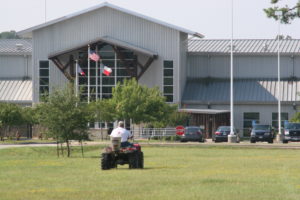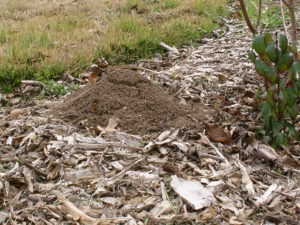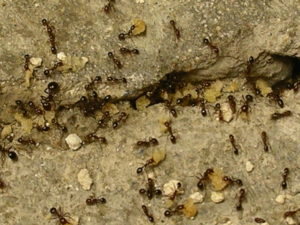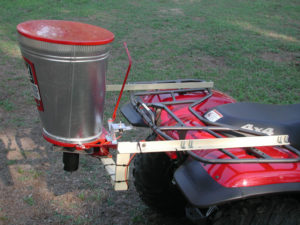By: Dr. Paul Nester, Extension Program Specialist – IPM, Houston/Metro area
When it comes to insect pests, fire ants would probably top everyone’s list! Red and black imported fire ants (Solenopsis invicta and Solenopsis richteri) are invasive species and their painful bites can injure or kill livestock, wildlife, domestic animals, and humans. Their large mounds (as many as 300 per acre) are unsightly and often damage mowers and other equipment. Fire ants also infest buildings and can damage electrical equipment by chewing on wire insulation.
Fire ants cost Americans $6 billion a year, including the cost of insecticides. The Two-Step Method and other approaches described here can lower that cost while reducing environmental damage and improving fire ant control. Knowing your options will allow you to make better choices to protect your family, pets, and property.
Identifying Fire Ants
There are hundreds of ant species in the southern United States, including some native fire ant species, and most of them are considered beneficial insects. Collectively, ants till more earth than earthworms and some prey on other insect pests to help to reduce their numbers.
Fire ants will build their mounds almost anywhere—in the open or next to a building, tree, sidewalk, or electrical box. A fire ant mound does not have a central opening. Fire ants emerge quickly and begin biting and stinging when the mound is disturbed. They will even run up vertical surfaces.
Worker fire ants are dark reddish-brown with shiny black abdomens, and are about 1/16- to about 1/4-inch long. Fire ants are similar in appearance to many other ants, so make sure you have correctly identified the species before attempting to solve your ant problem. If you are uncertain about the species, call your local extension office for assistance in identifying your ants.
Controlling Fire Ants
Most people and school districts (about 80 percent according to one survey) try to control fire ants by treating individual mounds. Mound treatments are expensive, up to $2 or more per mound, and require lots of time and labor if you have much land to treat. You can easily use too much insecticide, which may lead to environmental contamination if rain-washes the insecticide into lakes and streams. To be effective, the mound treatment must kill the queen(s). Otherwise, the colony will survive. Some nests may go undetected. Even an area where every mound has been treated can soon be re-infested by fire ant colonies migrating from untreated areas or floating there on floodwater. In addition, deep-dwelling colonies that escaped mound treatment can quickly form mounds after a soaking rain. It is usually more effective and less expensive for School Districts to treat the entire yard with a product designed for broadcast application.
Fire ants cannot be eliminated because it is not possible to treat all infested areas. There may not be one best method for fire ant control, especially in large areas. Your objective should be to find the method or methods that are most cost-effective, environmentally sound, and fit your tolerance level for fire ants. In areas where these ants do not present problems, doing nothing is one option. For Texas Schools your best option is to implement an integrated pest management program (IPM) that gives everyone an idea about how fire ants will be controlled on district property.
Remember fire ant strings have been associated with student deaths, so designing an effective fire ant management program utilizing broadcast baits or long residual granules may be in the best interest of the school district.
Types of Control
Organic products: A few products are certified as organic. These include ingredients such as d-limonene, an extract from citrus oil, or spinosad, a chemical complex produced by a soil microbe. This could be your only option for your campus school garden or other areas where you need to be sensitive to the type of insecticide you are using.
Chemical control: The use of insecticides for fire ant control is regulated by the Environmental Protection Agency and Texas Department of Agriculture. Approved products must be used according to label directions. Read the label carefully! An approved product is one that has directions for fire ant control on the label. Be sure it is appropriate for where you intend to use it, particularly if you will be treating a vegetable garden or other food production site. Products for use in electrical utility boxes and indoors are for use only by pest management professionals who are licensed by the TDA.
Control Products
Most active ingredients are marketed under more than one brand or trade name. This article refers to the generic names of the active ingredients in insecticides, which you should see on the product labels. Some sample trade names are given as well.
Products are formulated as dusts, granules, liquid drenches, or baits. They are applied either to individual ant mounds or across the surface of the ground (broadcast). The various active ingredients affect ants in different ways.
Most active ingredients are contact insecticides that affect the nervous system of ants. Contact insecticides include acephate (Orthene®), carbaryl (Sevin®), fipronil (TopChoice®, Taurus® G, Quali-Pro® Fipronil 0.0143G or Taurus® Trio G) broadcast granules, which are restricted use professional products, pyrethrins, pyrethroids (bifenthrin, beta-cyfluthin, cyfluthrin, cypermethrin, deltamethrin, gamma-cyhalothrin, lambda-cyhalothrin, permethrin, esfenvalerate, tefluthrin, tralomethrin, or zeta-cypermethrin), and liquid spinosad formulations. These ingredients vary in how quickly they kill ants and how long they remain in the environment. Natural pyrethrins and synthetic pyrethroid ingredients kill ants in minutes. Acephate and carbaryl take about one day, while granular fipronil may take four to six weeks to eliminate colonies. Hot water, pyrethrins, and d-limonene treatments have little or no lasting effect. Carbaryl, spinosad, and acephate break down in a matter of days to weeks. Pyrethroids can remain in the environment for weeks to months, while fipronil can persist as long as a year.
Baits contain active ingredients dissolved in a substance ants eat or drink. Some bait ingredients affect the nervous system. These include abamectin (Ascend®, Award® II, or Clinch®), indoxacarb (Advion® or Ortho® Fire Ant Killer Mound Bait), metaflumizone (Altrevin®, or Siesta®), spinosad (Fertilome Come and Get It! or Payback), and fipronil (MaxForce FC). Some affect the digestive system (boric acid) or metabolism (hydramethylnon or Amdro® or Probait®). Other bait ingredients interfere with reproduction or growth. These include methoprene (Extinguish®), and pyriproxyfen (Distance® or Esteem®). A relatively new type of bait combines two active ingredients, hydramethylnon and methoprene (Amdro® Yard Treatment or Extinguish® Plus).
To be effective, baits must be fresh and applied when ants are actively foraging. To determine if the time is right for treatment, place a small amount of bait in the area to be treated and see if foraging ants remove it within an hour. Because ants collect, bait and return it to the colony, very little insecticide is needed. Baits are ruined by water, so do not water baits after application, or apply them when rain is expected.
Control Approaches – The Two-Step Method
Step 1. Broadcast fire ant bait once or twice a year (fall and spring) to reduce fire ant colonies by 80 to 90 percent.
Step 2. Treat nuisance mounds or colonies that move into the bait-treated areas. Step 2 may not be needed.

To control fire ants on school campuses it is recommended that you broadcast bait using an appropriate spreader.
Baiting is the most cost-effective and environmentally sound approach to treating medium to large landscape areas. The bait you apply determines how quickly ants will be controlled and how long the effect will last. Faster acting bait products include indoxacarb (works in 3-7 days), metaflumizone (works in 7-10 days), hydramethylnon (works in 7-14 days for mound treatments and in 2-3 weeks when broadcast), and spinosad (works quickly on foraging ants but may take several weeks for reduction in mound activity). These baits may need to be reapplied more often than slower acting and longer lasting products such as abamectin, methoprene or pyriproxyfen, which work in 1-2 months when applied in spring and six months when applied in fall. Products that combine fast- and slow-acting ingredients, such as hydramethylnon plus methoprene (Extinguish® Plus or Amdro® Yard Treatment), may control ants better because they act quickly and has a longer effect on the colony. Certified organic products that contain spinosad such as Fertilome® Come and Get It! or Payback® Fire Ant Bait can be used for broadcast bait and mound treatments. Use products such as Amdro® Pro, Esteem®, Extinguish®, or Extinguish® Plus for livestock pastures and hay fields.
Always read and follow the application instructions on the label of the product you are using. Use a hand-held spreader/seeder or a standard push spreader to correctly broadcast bait products. Use the hand-held spreader/seeder for baits that are applied at very low rates such as one to five pounds of product per acre. Use the push-type lawn for baits that are applied at higher volumes per acre (two to five pounds per 5000 – 10,000 square feet for example, Amdro® Yard Treatment).
Use a vehicle-mounted spreader such as the Herd® GT-77 to cover large areas. For home lawns, calculate the area to be treated and use the smallest spreader setting that allows bait to flow. Apply the bait in swaths, crisscrossing swaths if needed, until the specified amount is applied. For larger areas, see How to Calibrate a Fire Ant Bait Spreader located at http://articles.extension.org/pages/12228/how-to-calibrate-a-fire-ant-bait-spreader. The agitators in some spreaders may cause bait to cake up so that it does not flow properly.
Individual Mound Treatments
Although treating ant mounds individually is more labor-intensive and may use more insecticide than other methods, it is a suitable approach for small areas with few fire ant mounds (fewer than 10 per acre) or where you want to preserve native ants. Bait products (hydramethylnon, indoxacarb, metaflumizone, or spinosad) can be used to treat individual ant mounds and are ideal for treating inaccessible colonies like those nesting under sidewalks, in plant beds, and at the bases of tree trunks. Remember when using single mound treatments you will only treat the mounds you see not the mounds you don’t see. So using only single mound treatments may allow a population of active foraging fire ants to remain in an area, resulting in frequent re-treats to an area.
Some mound treatment products are available as liquid drenches, injectable aerosols, dusts, or granules that are watered in to the mound. Ants are killed only if the insecticide contacts them, so proper application is essential. These treatments are most effective when ants are nesting close to the mound surface (as they do when the temperature is mild). Colonies should not be disturbed during treatment. If you use a watering can to apply insecticide, do not use the can later for other purposes.
Long-residual Broadcast Contact Insecticide Treatments
With this approach, a contact insecticide is applied to the lawn and landscape surface. This is more expensive than other control methods but it may be more effective in smaller areas because ants that move into treated areas will be eliminated if the chemical is active. Granular products are best applied with a push-type fertilizer spreader and must be watered in after treatment. Granular fipronil products (TopChoice®, Taurus® G, Quali-Pro® Fipronil 0.0143G) are slower acting but longer lasting and only one treatment is permitted per year. Faster-acting contact insecticides, such as the pyrethroids (listed above), eliminate ants on the surface for months but may not eliminate colonies nesting deeper in the soil. The product Taurus® Trio G is a fipronil granule with added pyrethroids so you not only get quick knockdown of foraging fire ants with the pyrethroids but the longer lasting control due to the firpronil active ingredient.
(Note: For Texas School IPM Programs, TopChoice®, Taurus® G, Quali-Pro® Fipronil 0.0143G or Taurus® Trio G, are considered Yellow Category per TDA rules for school IPM.)
Make a Management Plan
Chemical control lasts only as long as the effects of the insecticide used, or until new ant colonies move in from untreated areas. You can expect an ant infestation to return to its original level eventually. Thus, keeping fire ants in check requires a commitment of time and money. To reduce the cost and make control easier, consider making a map of your property. Divide the property into treatment areas and designate the most appropriate treatment approach for each area. Make and maintain a schedule for first treatment and any necessary re-treatments.
For example, you might use a long-residual broadcast contact insecticide at regular intervals in high-value or high-traffic areas (near buildings or in play or recreation areas) where maximum control is needed. In other areas, where 80 to 90 percent control of ants is acceptable, you might use the Two-Step Method. Because control lasts longer when large areas are treated, consider participating in a community- or neighborhood-wide treatment program. These have been shown to improve control and reduce cost. If everyone participates by making coordinated treatments, ant colonies will not be able to migrate from property to property.




 .
.